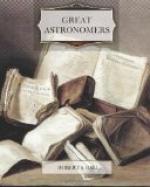[Plate: Roman Catholic church at Parsonstown.]
It was once my privilege to be one of those to whom the illustrious builder of the great telescope entrusted its use. For two seasons in 1865 and 1866 I had the honour of being Lord Rosse’s astronomer. During that time I passed many a fine night in the observer’s gallery, examining different objects in the heavens with the aid of this remarkable instrument. At the time I was there, the objects principally studied were the nebulae, those faint stains of light which lie on the background of the sky. Lord Rosse’s telescope was specially suited for the scrutiny of these objects, inasmuch as their delicacy required all the light-grasping power which could be provided.
One of the greatest discoveries made by Lord Rosse, when his huge instrument was first turned towards the heavens, consisted in the detection of the spiral character of some of the nebulous forms. When the extraordinary structure of these objects was first announced, the discovery was received with some degree of incredulity. Other astronomers looked at the same objects, and when they failed to discern—and they frequently did fail to discern—the spiral structure which Lord Rosse had indicated, they drew the conclusion that this spiral structure did not exist. They thought it must be due possibly to some instrumental defect or to the imagination of the observer. It was, however, hardly possible for any one who was both willing and competent to examine into the evidence, to doubt the reality of Lord Rosse’s discoveries. It happens, however, that they have been recently placed beyond all doubt by testimony which it is impossible to gainsay. A witness never influenced by imagination has now come forward, and the infallible photographic plate has justified Lord Rosse. Among the remarkable discoveries which Dr. Isaac Roberts has recently made in the application of his photographic apparatus to the heavens, there is none more striking than that which declares, not only that the nebulae which Lord Rosse described as spirals, actually do possess the character so indicated, but that there are many others of the same description. He has even brought to light the astonishingly interesting fact that there are invisible objects of this class which have never been seen by human eye, but whose spiral character is visible to the peculiar delicacy of the photographic telescope.




